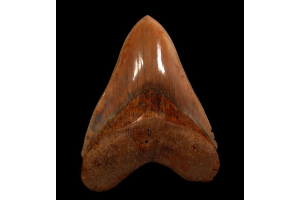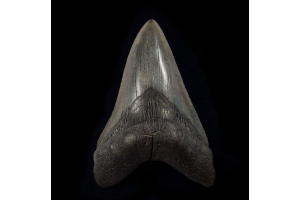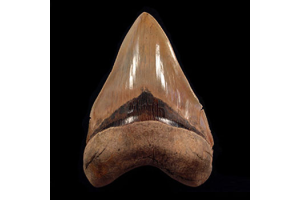Page 7 - Gary Greaser
- - November 10, 2025
The ocean has always kept its secrets well. From the hush of the deep blue to the fossils hidden in ancient sands, every discovery reveals whispers of what once ruled the seas. Among these relics lies something so small yet so astonishing—a baby megalodon tooth. Though miniature compared to the adult’s formidable size, it carries an ancient story of beginnings, evolution, and oceanic dominance.
It’s fascinating to think that even the tiniest fossil fragment can hold echoes of creatures that once swam the waters millions of years ago. This isn’t merely a collector’s find—it’s a window into the prehistoric world.
Tracing the Origin of a Giant
Imagine holding a piece of history between your fingers, one that predates humans by millions of years. A megalodon, often hailed as the largest shark that ever existed, began its life much like any other creature—in miniature form. Its early teeth, more minor yet intricately detailed, hint at the massive predator it would become.
Every ridge, curve,
- - November 10, 2025
The Megalodon was one of the largest predators to ever live in the ocean. If you have ever wondered how big can a megalodon tooth get, you are not alone. These teeth are more than just fossils. They tell the story of a giant shark that ruled the seas millions of years ago.
In this article, we will explore the different sizes of Megalodon teeth. From small teeth found by beginners to huge teeth that are rare and valuable, you will learn what makes these teeth so special. If you want to know about megalodon tooth size and how these ancient sharks lived, keep reading!
The Power Behind the Tooth
The Megalodon was a massive shark that lived millions of years ago. Its teeth give us clues about its size and strength. Many people ask, how big can a megalodon tooth get. Some of the biggest teeth are more than seven inches long. That is as long as a human hand!
The size of a tooth can tell us a lot. Bigger teeth belonged to older sharks or those at the front of the jaw. Smaller teeth often
- - November 10, 2025
Few classroom moments rival the wonder that lights up a student’s face when they hold a piece of history that predates humanity itself. That’s what happens when teachers, homeschoolers, and museum educators introduce their students to authentic fossils—especially real megalodon teeth for sale. These prehistoric marvels are more than captivating artifacts; they’re hands-on gateways into Earth’s deep past, sparking curiosity, critical thinking, and scientific discovery all at once.
At Buried Treasure Fossils, we’ve spent over two decades helping educators and enthusiasts bring the ancient world to life. Our passion for fossils—and the stories they tell—makes learning tangible, unforgettable, and endlessly exciting.
The Power of Learning Through Touch
Children and adults alike learn best when they can touch, hold, and examine real objects. Fossils, especially something as massive as a megalodon tooth, bridge the gap between imagination and reality. When a student runs their fingers across
- - November 10, 2025
There’s something extraordinary about holding a piece of ancient history in your hands. Few objects inspire curiosity and wonder like prehistoric shark teeth—especially when they belong to the legendary Otodus megalodon. At Buried Treasure Fossils, we believe these magnificent specimens are more than collector’s items—they’re powerful, hands-on learning tools that ignite scientific curiosity in children and foster a lifelong passion for discovery.
The Fascination of a Prehistoric Giant
The Otodus megalodon—the largest shark to have ever lived—once dominated the oceans over 3 million years ago. This massive predator could grow up to 60 feet long, with jaws strong enough to crush whales. For a young scientist, simply learning about its size and power opens the door to countless questions: How did such an animal evolve? What did it eat? Why did it disappear?
At our store, we’ve seen how even a single fossilized tooth can trigger hours of exploration. It becomes more than just a fossil—it’s
- - November 10, 2025
At our fossil collection site, we take great pride in curating remarkable discoveries that bring the ancient world to life. Among these treasures lies a tooth that radiates both mystery and magnificence. Its copper red enamel gleams softly, while its sturdy root anchors it to an age long past. This exquisite specimen, discovered in the Meherrin River area of North Carolina, originates from the “Red Site,” a location celebrated for producing the most vibrant copper-red Megalodon fossils.
Each detail of the enamel and root holds a quiet narrative, offering a glimpse into a creature that once ruled the seas. The story of the Otodus megalodon in Copper Red Site begins here, etched in color, texture, and time.
The Enamel: A Chronicle of Color and Preservation
The enamel of this specimen tells a story through color alone. Its copper-red hue sets it apart from the typical gray or black tones seen in other Megalodon fossils. This deep coloration formed naturally through mineral-rich sediments
- - November 10, 2025
Somewhere along a quiet shoreline, the tide pulls back and reveals a fragment of time—dark, triangular, and gleaming faintly beneath the sand. Your heart skips a beat as you realize it could be something extraordinary: a relic from one of the most formidable predators that ever lived. Long before humans walked the earth, the megalodon dominated the seas. Today, finding a megalodon tooth connects us to that ancient past in a tangible way, letting us hold millions of years of history in our hands.
The thrill of such a discovery isn’t just about the fossil itself; it’s about the moment of recognition—the instant when you realize you’ve unearthed a piece of Earth’s forgotten story.
Why These Ancient Giants Still Fascinate Us
Megalodons, often measuring more than fifty feet long, once ruled the oceans with unmatched strength. Their massive teeth—some over seven inches—were designed for crushing bone and devouring large prey. Although they disappeared around three million years ago, their presence
- - November 10, 2025
Imagine holding a relic that once belonged to one of the ocean’s most formidable creatures—a fossilized memory of nature’s untamed era. Worn around the neck, this fragment of history becomes more than jewelry; it’s a silent story of survival, mystery, and awe. A megalodon tooth necklace captures this connection between humanity and the deep, reminding us that beauty often lies in the echoes of the past.
Each tooth once belonged to a predator that ruled the seas millions of years ago —a shark so large that its bite could crush bones with ease. Today, these fossils are admired not for their ferocity but for their form—fossilized enamel polished by time, revealing stunning shades of gray, tan, and black.
As you explore the idea of wearing one, you’re not just choosing an accessory; you're also making a statement. You’re embracing a conversation piece that whispers of lost oceans and colossal creatures.
The Allure of Fossil Jewelry
Fossil jewelry holds a charm unlike anything crafted by modern
- - November 10, 2025
At our fossil collection, we take pride in offering specimens that capture the timeless beauty of Earth’s ancient past. Among them, the Otodus megalodon from Indonesia holds a special place. These remarkable fossils have fascinated us with their exceptional preservation, color, and structure.
Each specimen allows us to glimpse into a prehistoric world where colossal predators once ruled the oceans. Their natural artistry and geological perfection make them among the most captivating fossils we offer.
Geological Origin and Preservation
The story of Indonesian Otodus megalodon teeth begins deep within the limestone formations of West Java. These fossils are often recovered from the Bentang Formation, a geological layer that dates to the Middle Miocene epoch, around 10 to 15 million years ago. Within this limestone, the teeth have remained protected for millions of years, allowing them to retain their detailed structure and natural sheen.
Because these fossils were buried under stable
- - November 10, 2025
The ocean has always been a place of mystery, where time seems to stand still and legends often blur with reality. From shimmering coral reefs to the dark trenches of the deep, every current hides a story waiting to be told. Among these stories lies one of the most extraordinary creatures ever to have existed—the Carcharocles megalodon, a name that continues to stir curiosity and wonder among scientists and explorers alike.
The mere idea of this prehistoric predator lurking in unexplored waters sparks imagination. What if, in the remote corners of our planet’s vast ocean, traces of the ancient giant still remain?
Tracing the Shadows of a Giant
New Caledonia, surrounded by the South Pacific’s brilliant blues and hidden depths, offers a unique geological setting for fossil discoveries. Beneath its calm lagoons and sharp coral ridges lie sedimentary layers that have preserved fragments of Earth’s ancient marine history. Fossilized teeth found in similar regions give us an idea of the megalodon’s
- - November 10, 2025
Long before humankind gazed upon the stars or built civilizations, enormous creatures ruled the oceans. Among them was the megalodon—a colossal predator whose bite could crush the bones of whales and whose presence defined marine dominance. Its existence may have faded millions of years ago, but the secrets it left behind are captured in the relics that resurface from ancient sediments. The Aurora Megalodon tooth embodies one of those enduring connections—a fragment of history that bridges us to an untamed past.
These fossils, once part of the jaw of the largest shark to ever live, tell stories beyond mere survival. Each groove, ridge, and shade speaks of shifting seas, vanished ecosystems, and the rhythm of prehistoric life.
From the Depths of Lee Creek to the Surface of Discovery
One of the most remarkable sources of these fossilized treasures is the Lee Creek Mine in North Carolina. Once an active phosphate mine, it now serves as a geological time capsule, preserving remnants of a world







